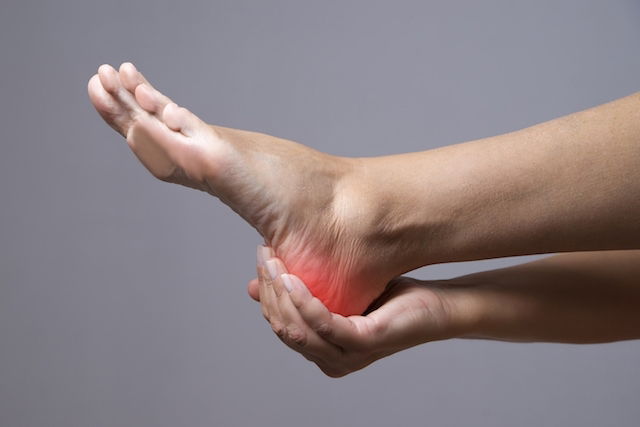Heel pain can be a result of by foot issues, like direct trauma, plantar fasciitis, heel spurs, bursitis gout or Sever’s disease. This conditions can be triggered due to prolonged standing, using inappropriate footwear, excess weight or intense physical activity.
It is important to consult an orthopedic surgeon, rheumatologist or family doctor if your heel pain does not improve with time, if the pain is very intense and/or you have difficulty walking. The doctor may order testing to identify the underlying cause, which will help to orient the appropriate treatment.
To relieve heel pain, patients may find relieve from resting, using anti-inflammatories, purchasing in-soles for the shoes, stretching and joint strengthening.

Main causes
Heel pain is caused by:
1. Changes to foot shape
Changes to foot shape can interfere with walking and gait, leading to foot and heel pain. Changes to foot shape can be noted soon after birth, or they can emerge as a result of inappropriate footwear or sports.
More common conditions that cause heel pain include flat foot, bow leggedness, and knock knees. These conditions are associated with unusual overloading on a joint or bone.
What to do: In these cases, the doctor may prescribe exercises to correct posture, in-soles or even surgery. It is important to consult an orthopedic surgeon or physiotherapist to evaluate the presenting symptoms and devise an optimal treatment plan.
2. Foot trauma
Foot trauma from direct blows, worn-down soles, high heels or intense running can all cause heel pain.
What to do: You should take time to rest your injury. The time dedicated to resting depends on the severity of the injury, and can vary from 2 days to 1 week. If pain persists for longer, you should have the foot assessed by a doctor to rule out a more serious condition. The doctor may prescribe anti-inflammatories or immobilization of the affected foot.
A good tip for a speedy recovery is to apply cold compresses, which will help to reduce inflammation and swelling, as well as comfortable footwear.
3. Plantar fasciitis
Plantar fasciitis is an inflammation of the tissue, or fascia, of the bottom of the foot which is caused by repetitive trauma or injuries. Inflammation can also occur as a result of standing for prolonged periods, being overweight or excess exercising.
Heel pain from plantar fasciitis tends to be more intense in the morning and worsens when starting to walk, until it gradually lessens. Some patients experience swelling in hte area and difficulty walking or using shoes.
What to do: You are advised to stretch your calves and feet, to perform strengthening exercising and to massage the affected area. The doctor may also prescribe specific treatment, like corticosteroid injections, radiofrequency ablation or using a splint to sleep.
4. Heel spurs
Heel spurs can emerge due to increased pressure on loading on the bottom of the foot. It is most common in people over 40 years of age, those who are overweight, those with a history of a foot deformity, or those who run intensely.
What to do: Heel spur treatment is usually initiated when there is local swelling, particularly if it presents with plantar fasciitis. The doctor may recommend ice, rest and anti-inflammatories. These interventions are usually sufficient, and surgical removal of the heel spur is rarely necessary.
5. Heel bursitis
A bursa is a small fluid-filled sac that is found between the heel bone and achilles tendon. IT can become swollen in some situations, causing pain at the back of the heel that worsens when moving.
What to do: To treat heel bursitis, the doctor may prescribe anti-inflammatories, cold compresses, physiotherapy, stretching and exercise.
6. Sever’s disease
Sever‘s disease is associated with pain in the heel bone growth pain. This condition is most common in children who participate in high-impact sports, like running, gymnastics, high jumps and dancing (particularly ballet).
What to do: Training intensity and jumps should be limited to prevent worsening. Pain can be relieved by applying a cold compress to the area for 20 minutes. The doctor may recommend an insole to support the heel in the shoes. To prevent flare-ups, patients are advised to warm-up with a 20 minute walk.
7. Gout
Gout is an inflammatory disease caused by access uric acid in the blood. Uric acid can start to accumulate in the joints and cause inflammation and intense pain. It is most commonly felt in the big toe, however some patients report heel pain as well, as the feet are the first place for uric acid to start building-up.
What to do: Treatment for gout flare-ups should be guided by the doctor, who may prescribe anti-inflammatories (like naproxen and ibuprofen) or more specific medications that help to regulate uric acid levels. Read more about a gout diet to see which foods you can eat and what you should avoid when treating gout.
